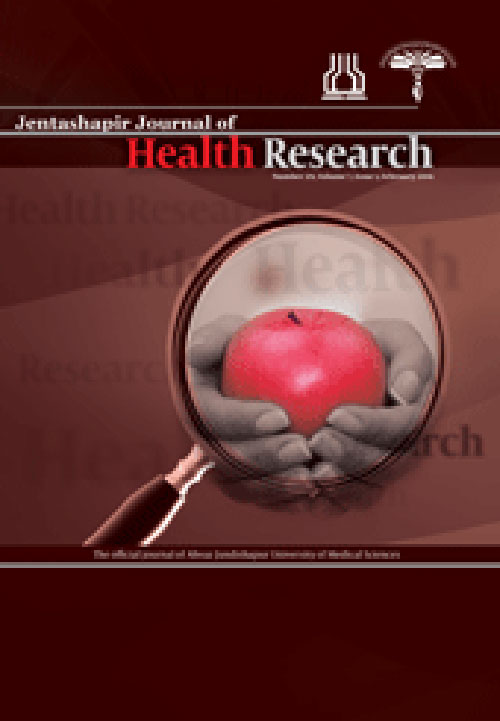فهرست مطالب

Jentashapir Journal of Cellular and Molecular Biology
Volume:9 Issue: 2, Apr 2018
- تاریخ انتشار: 1397/01/15
- تعداد عناوین: 4
-
-
Page 1Background
When a method is unusual, the intention is very strong and then prevention becomes a big challenge; although, suicide is a preventable public health problem.
ObjectivesThe author aimed to look into unusual methods of suicidal attempts so that they can be considered in the formulation of prevention strategies.
MethodsA search was done in PubMed, PubMed Central, Google, Google Scholar, and BanglaJOL with specific searching key words between 2000 and 2017. Eventually, 23 articles were selected purposively for review.
ResultsNine suicide cases were reported as unusual poisoning, eight attempts were by violent methods, four by stabbing, and another four by unusual asphyxia. The mean age of the victims was 39.96 years, ranging from 17 to 80 years old, 68% being male. A total of 18 (72%) respondents died by the act, while 28% were saved from fatal attempts. Of the victims, 36% were found to have mental disorders, i.e. 28% had depression, 4% had schizophrenia, and 4% had bipolar 1 disorder. Seven cases had notable risk factors and two had a history of previous attempts.
ConclusionsAdult males are more prone to use unusual methods. Males used violent methods more than females, whereas females used more unusual poisoning methods. Asian and south Asians used more poisoning methods than those from other parts of the world.
Keywords: Unusual Suicide, Unusual Mode, Unusual Method -
Page 2BackgroundInternationally previous publications confirmed that skin cancer could be categorized as one of the most common cancers.ObjectivesThis study aimed to investigate the skin cancer crude rate and incidence in Isfahan/Iran.MethodsData (2011 - 2015) was collected from the Isfahan Cancer Registry. The skin cancer was defined by topography code C43 and C44. Period prevalence and incidence was calculated per 100 000 persons.ResultsThere were 3837 patients that corresponded to a period prevalence of 77.1. With a minimum of 5 and a maximum of 103, skin cancer in 67% was defined at the age between 60 and 70 years. Malignant melanoma of skin was reported in 8 out of total population in which all died from it at the age between 42 to 95 years. There was an increase in incidence from 17.4 to 22.3, in which the mean incidence in males (24) was significantly higher (PConclusionsIn the total population, death was reported data in 2% of patients with skin cancer. A 28.2% increase in incidence and 69.1% higher crude rate of males (96.2) versus females (56.9), which recommends further research in this direction.Keywords: Epidemiology, Skin, Cancer, Prevalence, Iran, Melanoma
-
Page 3BackgroundThe most common type of childhood cancer is leukemia, therefore, the aim of this study was to evaluate the survival rate and its effective factors in patients with malignancies under the age of 18 years in Hamadan province, during the years 2007 to 2016.MethodsIn this historical cohort study, data were collected from the files of a hospitals archive of Hamadan province, and the log-rank test was used to compare the survival curves. Modeling of survival factors was done by using the Cox regression model.ResultsThe most frequent age group was 5 to 9 years old and there were 53 (37.9%) males and 86 (61.4%) females. The risk ratio for people with white blood cell count above 50000 to that of under 10000 was 2.260 (P value = 0.035) and for those with platelet levels above 50000 compared with those, who had levels less than 50000 was 0.376 (P valueConclusionsThe results of this study were similar to that of similar studies in most of the examined cases, those with lower white blood count (WBC) count, and patients with high blood platelets had a higher survival rate than those with a lower risk profile. Regarding the variable relapse status, less survival was reported for those, who had relapses than those, who did not show relapse.Keywords: Acute Leukemia, Survival, Children, Cox Mode
-
Page 4BackgroundThe present study was conducted to determine the observance level of educational accreditation standards in teaching hospitals of Mazandaran University of Medical Sciences in 2016.MethodsThe present descriptive and analytical study was conducted to assess the observance level of educational accreditation standards in teaching hospitals of Mazandaran University of Medical Sciences in 2016. The given check list was sent by the Ministry of Health and Medical Education to the university. The checklist included 10 areas of assessment (educational management team, monitoring and supervision, faculty members, students, facilities and resource's management, emergency, programs and processes, committees, the patient's rights and safety, and clinical research).ResultsAccording to the results, Imam Khomeini (RA) Health Care Center had a descending process of accreditation standards (at two stages). In addition, Zare Center had no significant changes. In other cases, a significant growth was observed in health care centers achieving accreditation standards.ConclusionsIt is necessary to discover and resolve causes and defects of reduced standards in some centers during both stages of assessing accreditation in addition to trying to strengthen and improve the state of implementing accreditation standards in all health centers.Keywords: Educational Accreditation Standards, Educational Hospital, Iran

